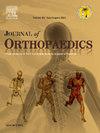计算机导航全膝关节置换术治疗外翻膝关节的软组织平衡和部件对齐评价
IF 1.5
Q3 ORTHOPEDICS
引用次数: 0
摘要
目的计算机导航全膝关节置换术(CN-TKA)有助于提高骨切割的准确性、软组织平衡和部件放置。然而,CN-TKA对外翻畸形的有用性尚不清楚。本研究旨在评估CN-TKA治疗外翻畸形的有效性,并将其与CN-TKA治疗膝内翻的效果进行比较。方法共74例cn - tka患者,其中外翻20例,内翻54例。植入后,记录三种情况(无应力、外翻应力和内翻应力)下全伸、30°和90°屈曲时术中髋关节-膝关节-踝关节(HKA)角度,计算内侧和外侧松紧度。术后x线片测量股胫角(FTA)、HKA角、髌骨倾斜、机械股骨外侧远端角(mLDFA)、机械胫骨内侧近端角(mMPTA)。术后1年测定膝关节损伤和骨关节炎预后评分(kos)和Lysholm评分。结果膝内翻完全伸展时的外侧松弛度明显大于膝外翻(外翻0.5±0.7°,内翻1.2±1.0°,p = 0.011)。屈曲90°时外翻膝关节内侧松弛度明显大于膝内翻(外翻0.4±0.6°,内翻0.1±0.3°,p = 0.004)。两组术后FTA、HKA角度、髌骨倾斜度、mLDFA、mMPTA、oos评分、Lysholme评分差异均无统计学意义。结论与CN-TKA治疗膝内翻相比,CN-TKA治疗膝外翻具有良好的软组织平衡和部件对准效果。本文章由计算机程序翻译,如有差异,请以英文原文为准。
Evaluation of soft tissue balancing and component alignment in computer-navigated TKA for valgus knee
Purpose
Computer-navigated total knee arthroplasty (CN-TKA) is useful for improving the accuracy of osseous cuts, soft tissue balance, and component placement. However, the usefulness of CN-TKA for valgus deformity remains unclear. This study aimed to assess the availability of CN-TKA for valgus deformities and compare it with CN-TKA for varus knees.
Methods
A total of 74 cruciate-retaining CN-TKAs (20 valgus, 54 varus) were included in this study. After implantation, the intraoperative hip-knee-ankle (HKA) angle was recorded during full extension and at 30° and 90° of flexion under three conditions (no stress, valgus stress, and varus stress), and the medial and lateral laxities were calculated. The femorotibial angle (FTA), HKA angle, patellar tilt, mechanical lateral distal femoral angle (mLDFA), and mechanical medial proximal tibial angle (mMPTA) were measured on postoperative radiographs. The Knee Injury and Osteoarthritis Outcome Score (KOOS) and Lysholm score were determined at 1 year postoperatively.
Results
The lateral laxity of varus knee in full extension was significantly larger than that of valgus knee (valgus: 0.5 ± 0.7°, varus: 1.2 ± 1.0°, p = 0.011). The medial laxity of valgus knee at 90° of flexion was significantly larger than that of varus knee (valgus: 0.4 ± 0.6°, varus: 0.1 ± 0.3°, p = 0.004). There were no significant differences in the FTA, HKA angle, patellar tilt, mLDFA, mMPTA, KOOS scores, or Lysholme score between the two groups postoperatively.
Conclusion
CN-TKA for valgus knee demonstrated acceptable soft tissue balancing and component alignment and good early clinical results comparable to those of CN-TKA for varus knees.
求助全文
通过发布文献求助,成功后即可免费获取论文全文。
去求助
来源期刊

Journal of orthopaedics
ORTHOPEDICS-
CiteScore
3.50
自引率
6.70%
发文量
202
审稿时长
56 days
期刊介绍:
Journal of Orthopaedics aims to be a leading journal in orthopaedics and contribute towards the improvement of quality of orthopedic health care. The journal publishes original research work and review articles related to different aspects of orthopaedics including Arthroplasty, Arthroscopy, Sports Medicine, Trauma, Spine and Spinal deformities, Pediatric orthopaedics, limb reconstruction procedures, hand surgery, and orthopaedic oncology. It also publishes articles on continuing education, health-related information, case reports and letters to the editor. It is requested to note that the journal has an international readership and all submissions should be aimed at specifying something about the setting in which the work was conducted. Authors must also provide any specific reasons for the research and also provide an elaborate description of the results.
 求助内容:
求助内容: 应助结果提醒方式:
应助结果提醒方式:


